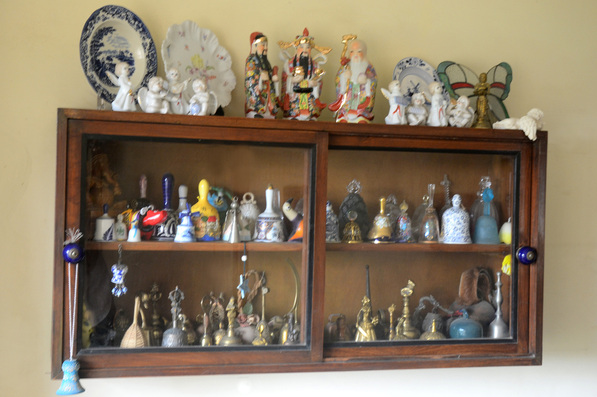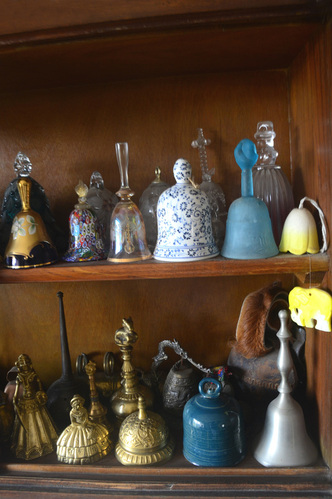|
I have been collecting bells for more than twenty years. I try to bring back a bell from every place that I travel to, so each of the bells in my collection brings back happy memories. Some of my bells are gifts from friends and family members, and some are flea market finds that I chanced upon. I do not buy every bell that I come across (my home would then be overrun with bells) but only buy those that appeal to me because of their unusual appearance, history, or sound. Here are some bells from my collection... Here's an excerpt from an article I wrote about bells for the Children's Digest magazine.
Bells are amongst the oldest manmade musical instruments in the world, and from the earliest times, the most basic use of bells was to call people to worship and prayer. In Ancient Greece, the ringing of bells announced that freshly caught fish had arrived at the market! In Rome, bells called the people to worship at temples, and sonorous bell ringing accompanied the funeral services of mighty Roman emperors. In times of war, bells were rung to alert the people when enemy forces were approaching the gates of a city or fort. Bells were also treasured in these civilizations as patriotic symbols or war trophies. In fact, one of the first acts of invaders was to silence the bells of conquered cities! The shapes of bells depend on their cultural environment, their intended use, and the materials used in their composition. All tower bells in the western world are tulip shaped with a sound bow, or a bulge near their rim. In East Asia, bells are barrel shaped. Chinese bells often have lotus shaped rims. Bells in Asia do not have a sound bow. It is interesting to note that almost all Asian bells have convex walls, so the sound of these bells is produced and focused within the bell itself. Bells made in the western Christian tradition however, are trumpet shaped, and so their sound reaches out, and can be heard over much longer distances. In India, large temple bell bells are made from ‘panchaloha’ which is an alloy made of gold, silver, copper, tin and lead, and are often crowned with images of popular deities like Hanuman or Ganesha, or mythical creatures like the Nandi Bull, or Garuda the great eagle. The pellet bell or ‘tiger bell’ is a spherical vessel with loose pellets rolling around inside. This bell, which is rather like a rattle, is of great antiquity, and is widely used in Asia. In India, Pakistan and Philippines these bells are used as a dance attribute. During the Mughal era in India, Emperor Humayun, hung a thick rope at the entrance of his magnificent palace at Agra. It was attached to a large bell, and Humayun a whimsical, but just king, decreed that if any of his subjects wanted justice from his monarch, all he had to do was ring the bell, and the Emperor himself would appear on his royal balcony to listen to the pleas! Many interesting anecdotes have been recorded in Indian history books about this particular idea of Humayun, and there is even one improbable, but fascinating tale of how the bell was once rung by a milking cow, who, desperate to be reunited with the newborn calf that had been wrested from her, decided to appeal to the Emperor himself! According to Hindu myth, when Shiva was performing his dance of bliss on Mount Kailash, a single bell from his anklet came loose, and rolled down the slopes of the lofty mountain peak. The sounds that it made as it rolled down – Tha-di-thom-nom- today form the basic syllables used in Indian dance. There's a famous line from the movie 'It's a Wonderful Life,' that explains why collectors like me are so enchanted by bells - "Everytime a bell rings, an angel gets its wings..."
0 Comments
Leave a Reply. |
AuthorArchives
November 2018
Categories |



 RSS Feed
RSS Feed
